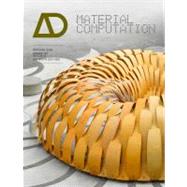- Architectural contributors include: Cristiano Cecatto, Neri Oxman, Skylar Tibbits and Michael Weinstock.
- A scientific perspective by Philip Ball and J Scott Turner.
- Features: Buro Happold's SMART group, DiniTech, Foster + Partners' Specialist Modelling Group, the Freeform Construction group and Stuttgart University's Institute for Computational Design.

Material Computation Higher Integration in Morphogenetic Design
by Menges, AchimBuy New
Rent Textbook
Used Textbook
We're Sorry
Sold Out
eTextbook
We're Sorry
Not Available
How Marketplace Works:
- This item is offered by an independent seller and not shipped from our warehouse
- Item details like edition and cover design may differ from our description; see seller's comments before ordering.
- Sellers much confirm and ship within two business days; otherwise, the order will be cancelled and refunded.
- Marketplace purchases cannot be returned to eCampus.com. Contact the seller directly for inquiries; if no response within two days, contact customer service.
- Additional shipping costs apply to Marketplace purchases. Review shipping costs at checkout.
Summary
Author Biography
Achim Menges is an architect, professor and the director of the Institute for Computational Design at Stuttgart University. He is also Visiting Professor in Architecture at Harvard University's Graduate School of Design and Visiting Professor for the Emergent Technologies and Design Graduate Program at the Architectural Association in London. Menges' research focuses on the development of integral design processes at the intersection of evolutionary computation, algorithmic design, biomimetic engineering and computer-aided manufacturing that enables a highly articulated, performative built environment. His projects have been published and exhibited worldwide and received international awards. Menges has lectured widely and published more than 60 papers and articles on his research over the last eight years.
Table of Contents
ch 1 Pattern Formation in Nature: Physical Constraints and Self]Organising Characteristics
ch 2 Evolutionary Architecture? Some Perspectives From Biological Design
ch 3 Material Resourcefulness: Activating Material Information in Computational Design
ch 4 Material Behaviour: Embedding Physical Properties in Computational Design Processes
ch 5 Material Capacity: Embedded Responsiveness
ch 6 Physical Drivers: Synthesis of Evolutionary Developments and Force]Driven Design
ch 7 Design to Self]Assembly
ch 8 Aggregate Structures: Material and Machine Computation of Designed Granular Substances
ch 9 Living Systems: Designing Growth in Baubotanik
ch 10 Programming Matter
ch 11 Material Articulation: Computing and Constructing Continuous Differentiation
ch 12 Material, Form and Force
ch 13 Engineering Integration: Real]Time Approaches to Performative Computational Design
ch 14 Manufacturing Reciprocities
ch 15 The Role of Additive Manufacturing and Physiomimetic Computational Design for Digital Construction
ch 16 Distinguishing Between the Drawn and the Made
An electronic version of this book is available through VitalSource.
This book is viewable on PC, Mac, iPhone, iPad, iPod Touch, and most smartphones.
By purchasing, you will be able to view this book online, as well as download it, for the chosen number of days.
Digital License
You are licensing a digital product for a set duration. Durations are set forth in the product description, with "Lifetime" typically meaning five (5) years of online access and permanent download to a supported device. All licenses are non-transferable.
More details can be found here.
A downloadable version of this book is available through the eCampus Reader or compatible Adobe readers.
Applications are available on iOS, Android, PC, Mac, and Windows Mobile platforms.
Please view the compatibility matrix prior to purchase.
